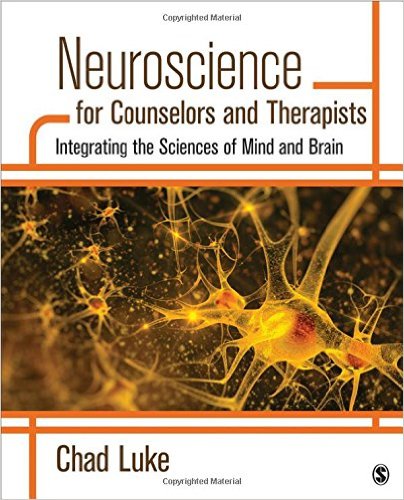 Dr. Chad Luke’s book, Neuroscience for Counselors and Therapists: Integrating the Sciences of Mind and Brain, is an excellent addition to any student’s, professor’s, or practicing clinician’s library. The book is written as a textbook but is surprisingly readable and has utility beyond the walls of the classroom. As neuroscience seems to be a force in the field of mental health, it is important for counselors to learn to integrate new knowledge rather than feel pressured to study a completely different discipline . This book is a first step in learning the basics about the brain and how this information could be integrated into counseling practice, without promising to be a “fix” or replacement for the techniques and skills already utilized by counseling professionals.
Dr. Chad Luke’s book, Neuroscience for Counselors and Therapists: Integrating the Sciences of Mind and Brain, is an excellent addition to any student’s, professor’s, or practicing clinician’s library. The book is written as a textbook but is surprisingly readable and has utility beyond the walls of the classroom. As neuroscience seems to be a force in the field of mental health, it is important for counselors to learn to integrate new knowledge rather than feel pressured to study a completely different discipline . This book is a first step in learning the basics about the brain and how this information could be integrated into counseling practice, without promising to be a “fix” or replacement for the techniques and skills already utilized by counseling professionals.
The structure of the text lends itself well to reading the book cover to cover and using the index to read the sections most applicable to your current practice. The beginning of the book sets the foundation for principles of neuroscience that are incorporated throughout the text. The field of neuroscience can be intimidating, especially because of the jargon and complex concepts that are outside the realm of social science. The first section discusses the physical structures of the brain, including neurotransmitters and basic brain functions. Any counselor who graduated more than a year or two ago and has not pursued continuing education in neuropsychology or neuroscience would find the first two chapters very helpful. Even if you have some knowledge of the brain, these chapters provide examples of how the information translates into the counseling relationship and case conceptualization, which is helpful when trying to incorporate the information into your own practice.
The second section of the book consists of four chapters that speak directly to theoretical orientations and the integration of neuroscience principles into those orientations. Dr. Luke assumes that most counselors reading the text have a solid understanding of theory prior to reading the book. He works from this assumption to pull major tenets from each theory and explain them in the context of neuroscience. These sections are well organized and full of client in session vignettes to bring the information to life.
The third and final section of the book is trans-theoretical and addresses commonly diagnosed or sub-clinical symptomology in the field of counseling through the lens of neuroscience. For counselors who identify more with an eclectic theoretical orientation, this section will hold special appeal. Dr. Luke examines anxiety, depression, stress and stress disorders, and substance abuse through the lens of neuroscience. He speaks to what these commonly diagnosed disorders look like in the brain and how neuroscience could be integrated into treatment options.
I appreciate that Dr. Luke isn’t claiming to be a neuroscientist but rather is a counselor educator interested in the clinical implications that neuroscience can have for his clients and students. This book is written by a counselor, for counselors, which makes it unique among the neuroscience literature. He has taken the time to read, digest and translate the information for counselors.
One of the few limitations I see in this text is the lack of information concerning how trauma affects the brain. Some sections left me feeling that I needed more information or that the author could have gone more in depth; more on multicultural issues and poverty would be a helpful addition. Trauma and poverty can have significant effects on the brain, and the symptomology can be seen within the counseling relationship. More on these topics could have been useful, especially for counselors working in community mental health settings or with underserved populations. The book itself is relatively short and thus a manageable read for a busy student or an equally as busy clinician or professor. The possible downside to having a manageable book is that it isn’t comprehensive; but then again, it could be argued that it should not be comprehensive. After all, we are counselors, not neuroscientists. We need to know enough information about neuroscience to support our clients on their path to wellness, which I believe this book fulfills.
Luke, C. (2016). Neuroscience for Counselors and Therapists: Integrating the Sciences of Mind and Brain. Thousand Oaks, CA: Sage.
Reviewed by: Charmayne R. Adams, The University of Tennessee, Knoxville
The Professional Counselor
